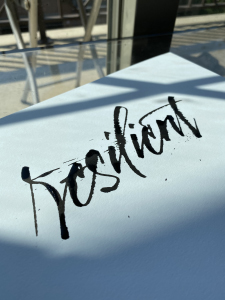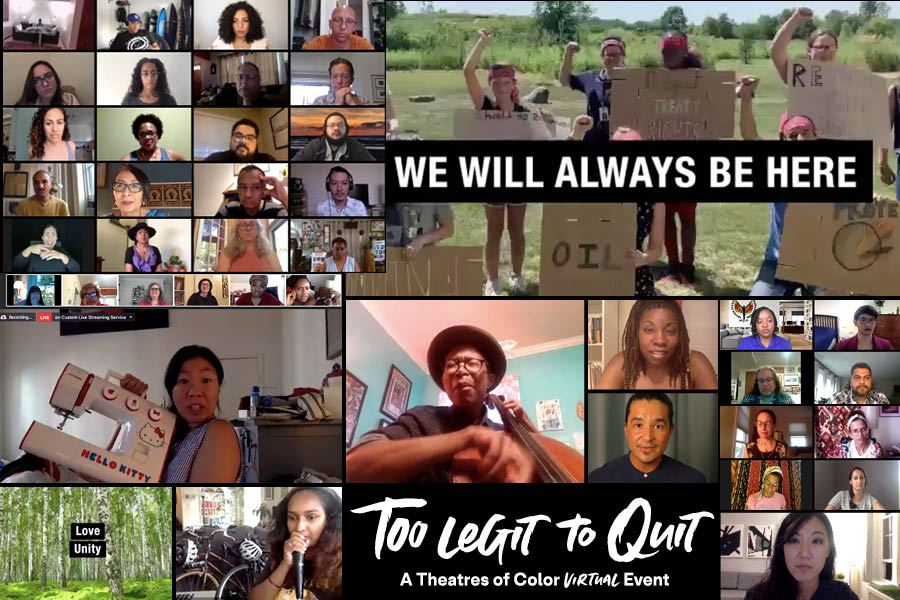As I write this I realize that I have a smile on my face and DJ Ushka’s music is still playing in my ear. I am reminded that theatre means “the seeing place.” How important it is to see and be seen. More than 300 people were seen in both a literal and non-literal sense on Zoom at the “Too Legit to Quit 3rd Annual Theatres of Color Gathering,” presented last Wed., Aug. 12, by Theatre Communications Group. While artists from all over the world are suffering from the isolation the pandemic has imposed on us, we were not alone. For a few hours we were together—truly together.
My ears always perk up while Selena plays. That’s how the event started, and we were each of us seemingly alone dancing in our homes—and then the realization came: I am not alone. Look at all the beautiful people dancing along with me! The chat went wild when “Put Your Lighters Up” played. Elena Chang, TCG’s director of Equity, Diversity & Inclusion initiatives, urged us to add to the Zoom chat where we’re located. One by one places from all around the world began to rush along the screen. It felt like the world was gathering. And though it hadn’t been said yet, the theme of the night was in full display: We are here. We are still here. We will always be here.
Teresa Eyring, TCG’s executive director, kicked off the night by reaffirming TCG’s new strategic plan. “We’ve redefined our mission as ‘to lead for a just and thriving theatre ecology.’” And there can be no just and thriving theatre ecology without theatres of color. This gathering thus served as both a call to advocacy and a celebration. We celebrated theatres of color, while realizing that there is still much work to be done in making their work visible and prosperous in the theatre community at large. We must work with theatres of color toward a more equitable theatre ecology.
Adrian Budhu, TCG’s deputy director, spoke about honoring the theatres of color and the importance of making time to connect during COVID-19. While living through a pandemic as an artist can be anxiety-ridden, TCG’s new mission to lead for a just and thriving theatre ecology can give hope for the field’s future. The excitement comes in what this “next normal” will be, and the hope that on the other side of this intermission we are taking as a community that theatre will be more inclusive and equitable.
The tone became somber as we all took a moment of silence, urged by Chang, who said, “While we meet tonight in the spirit of celebration, we do so knowing that so many of our colleagues are grieving the loss of life in Lebanon. We also meet during an ongoing uprising against police brutality and white supremacy, and a renewed assault on the voting rights of BIPOC communities. Let’s please take a moment of silence and solidarity.”
The careful balancing act between protest and joy continued with a film in place a traditional land acknowledgment, “We will always be here,” by Ty Defoe and Kate Freer, a beautiful work of art in its own right. While a land acknowledgement is a formal statement that recognizes and respects Indigenous peoples as traditional stewards of Turtle Island, this was so much more. The film not only took us to ancestral homes but also gave us visuals of what this land looks like, as the words blazed on the screen: “Home is Love, Family, Language, History, Light, Our Children, Our Ancestors, Blessing, Belonging.”
Next, a reminder to breathe in and out was welcome, as images of protest for the Black Lives Matter movement appeared on the screen. The words burned into my mind: “America is stolen land built by stolen people.” The film urged us to be unapologetically our whole selves for our children, the next generation, for Black Lives Matter, for climate change, for our LGBTQIA+ community, and against settler-sanctioned violence.
Emilya Cachapero, TCG’s director of Artistic and International Programs, shared that the commitment to nurture and support BIPOC theatres is not new to TCG but in fact stretches back decades. She pointed particularly to a significant marker: a 2003 convening of leaders from 21 BIPOC theatres at White Oak Plantation, Fla., which resulted in the formation of the Consortium of Asian American Theatres and Artists (CAATA) and in other BIPOC theatres engaging in peer mentoring on capital campaigns and advocacy. Then, in 2018, Ron Himes and the Black Rep hosted a meeting in St. Louis bringing together 47 BIPOC theatremakers and individual artists to build new alliances and organize around shared values.
As we watched a video of the St. Louis gathering, words echoed in the chat box, once more reminding us that we were not alone. As we sat in our living rooms, we were sharing this moment together. Like a chorus, words from the video were repeated in the chat: “Theatres of color tell the story of all people,” “Black theatre is different than plays with Black people,” “We make visible those who were made invisible.”

Protest and joy, joy and protest, switching back and forth while over 50 plus artists shared their talents with us. We began with Harold Steward, co-executive director of the Theatre Offensive, TCG board member and co-chair of TCG’s EDI board committee, introducing Jamaine Benjamin, Jr. and Darrian Whitehead of African Heritage Youth theatre, a group who performed at last year’s Theatres of Color Block Party in Miami. African Heritage Youth Theatre was founded over 20 years ago by the late, great Atim Johnson, who designed it as a space for students of color to come together and grow. Since then, AHYT has grown to be a distinguished youth theatre company led by Jazmin Jones-Oliver.
From one beautifully inspired performance, we were ushered to the next, this time by J.R. Pierce, associate editor of American Theatre magazine, who introduced Art2Action founding artistic director Andrea Assaf. Andrea is a member of the current cohort of TCG’s EDI Institute, as well as a steering committee member for the new National Alliance for Middle Eastern and North African Theatre Makers, and she serves as the national coordinator for the National Institute for Directing and Ensemble Creation.
The chat began to run wild again, as one person wrote, “I am overwhelmed by the beauty of this night.” Those words captured the feeling as Art2Action went on to showcase work from William S. Yellowrobe Jr., Kristina Wong, Anu Yadav, Ifrah Mansour, Spirit McIntyre, and Sunder Ganglani. The wisdom in Yellowrobe’s words still resounds with me, as do the humor and honesty in Wong’s message about the right to live and the right to healthcare. Mansour’s words inspired: “This is the after. After the fires. After the protest signs are thrown away. This is the after.” I am still haunted by the words of “Somebody Call My Name,” sung by the talented Spirit McInyre. Their tribute to Black Lives Matter, accompanied by cello, was striking and heartfelt.
The final piece was presented by Sunder Ganglani, a dramaturg and collaborator on Casting the Vote. This was described as “a creative occupation of democratic practice and a teach-in on the history of voter suppression,” and was undertaken with the collaboration of director Charlotte Brathwaite, journalist June Cross, composer Justin Hicks, and writer Janani Balasubramanian, as well as the Fisher Center at Bard and their community of high school and college students, New York Live Arts, and Art2Action. Said Ganglani, “I’m grateful for dissent in our stories, and discourse on the street—inside the confusion and anger there’s discourse building, rising, moving up and down Flatbush Avenue as I speak this introduction. I’m grateful for what democracy looks like right now—a phenomenon of relation, created person to person, moment to moment.”

The celebration continued as seven breakout rooms on Zoom split us into smaller groups. Each room hosted by a theatre of color featured an excerpt, talkback, clip from a COVID-impacted show, and/or a response to BLM. Theatres present included Golden Thread Productions with Crowded Fire Theater, KC Melting Pot Theatre, Teatro Luna, the Eagle Project, the Sống Collective, the Movement Theatre Company, and Hawaiian Theatre Program of the Department of Theatre and Dance, the University of Hawai‘i at Mānoa.
After the breakouts came the network of color calls to action. We heard from MENA Theatre Makers Alliance, Latinx Theatre Commons, Native Voices and Eagle Project, Black Theatre Network, Black Vitality Commission, Black Theatre Commons. A common theme emerged: The pandemic has revealed the necessity for us to stand together in our collective power. We can create culturally inclusive ecosystems. American theatre can be an inclusive place.
Emilya Cachapero ended by encouraging us all to take action. There are so many ways to do so: by filling out the U.S. Census online, as it’s important for us all to be counted; by speaking up against yellowface/brownface/blackface, including supporting the Beyond Orientalism national movement, in particular CAATA’s current efforts to fight yellowface on a recent production of Madama Butterfly in Little Rock; and by getting out to vote—it takes only two minutes to register.
As the night began to wind down, we were reminded that no virus can hold us Black, Indigenous, and people of color down. The night closed with even more dancing, led by the insanely talented DJ Ushka, as the celebration switched again from protest to joy and we danced into the night from the comfort of our own homes. The music filled the deep parts of our soul. Likewise may these words continue to fill those deep parts of us long after we close our computer screens. We are here. We are still here. We will always be here.
Cristina Pla-Guzman is a writer and educator based in Miami.
TCG creative/production team: Sarah Machiko Haber, Elena Chang, Annabel Guevara, Erica Lauren Ortiz, Monet Cogbill, Big Kongseng, Lauren Sullivan, Natalie Smith, and Anne Ciarlone.


